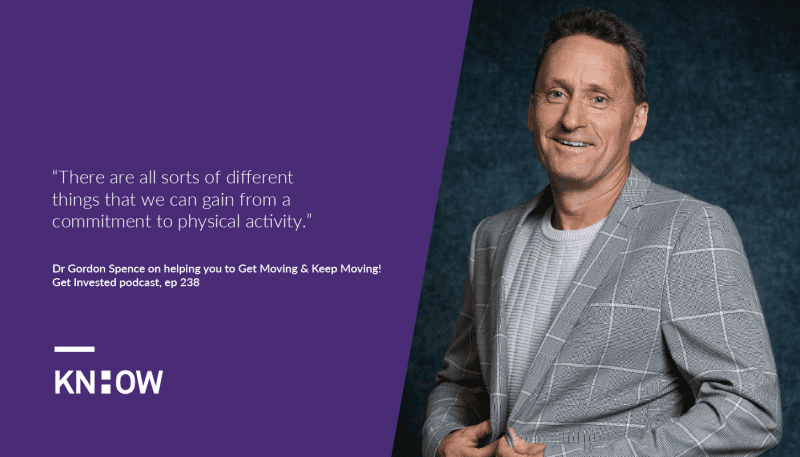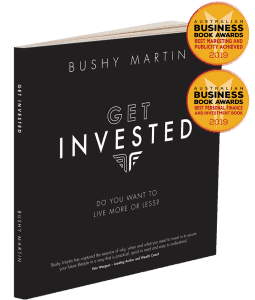Exercise scientist Dr Gordon Spence says finding the motivation to exercise, especially at an older age, will set you up for better quality of life.
Physical activity is key to sustainable performance and healthy ageing. But finding the motivation to get moving and keep moving can be tough, as the psychologist and author discussed with KnowHow founder Bushy Martin on the Get Invested podcast.
Why physical activity is crucial
“Our bodies are a design that we’ve evolved in a certain way, right? We’ve evolved on the basis of undertaking a certain amount of physical activity. We process fuel sources and we metabolise in particular ways based on the assumption that we will be moving to a certain degree,” Gordon said.
“And this is where we see the mismatches. The mismatch is because we live in these high convenience societies that don’t require us or don’t impel us to get active and to to move our bodies in ways that support good physical functioning. And so as soon as we start to stop using our bodies in a way that they were evolved to be used, we start running into strife.”
Harnessing your physical capacity in later years
“It’s a natural process to experience a physical decline. But what we do know is we are able to slow that process and not have it sort of kick off and accelerate on us because we’re not doing anything. So it’s a use it or lose it scenario. So it’s the opportunity to be able to get into your 60s, 70s, 80s and still be able to get out and be physically independent,” Gordon said.
“I know a lot of your listeners give a lot of time and attention to thinking about their financial independence. I think it’s also important to invest in physical independence as well, and doing things to maintain physical health across the decades in ways that keep those lifestyle diseases as a non-negotiable for us and allow us to really be able to enjoy life for as long as we can.
“I think what we need to recognise is that we are sitting on a whole lot of an untapped physical capacity. Even at 60, 70 or 80 it is available to you if you’re prepared to shape your life and create some routines that can allow it all to happen.”
Finding your motivation to exercise
Having the drive to keep exercising comes mostly from your interests and doing what you enjoy.
“People need a way of thinking about their health so that they can activate themselves and have it come from within. So generating that self-motivation for change, rather than doing it because the doctor and the health experts and everybody else in society is telling you that you should. Because that just sets up an unstable motivation,” Gordon said.
“So you’ve got to have a good basis of motivation. You need to know where you want to take it – you need to get moving and keep moving.”
Especially for those who are older, this motivation can often be found by reflecting and reminiscing on your adolescent days.
“Think back to earlier times in your life, potentially when you were a kid or an adolescent, and think about things you used to do that you really enjoyed. Then you can take it one step further. Let’s really enliven it by pulling out the trophies or the old photos or bringing up an old team mate, whatever it might be. Spend a little bit of time reliving it and reminiscing about it, because that can be a powerful source of energy.”
The next step is to project and consider your ideal lifestyle in the future.
“So in the first phase we look backwards, and in the second stage we’re looking forwards. We’re projecting forwards and thinking about what sort of healthy ageing future do I want to have? Let’s go forward to when you’re 65, 70, 75 and think about what do you want life to be looking like?” Gordon said.
“Because I think when it comes to that, people don’t often get clear enough about why they’re looking to do anything about their health. So you need to start sketching out almost like a personal vision of what that all looks like, if you’re going to make sense of anything you might be doing now.”
Ensuring you’re ready to commit
Once you’ve found your motivation and the type of physical activity you’d like to undergo, you need to make sure you’re fully prepared to commit.
“Your psychological readiness is really important. And what that means is, to what extent am I really on board with this? Am I really owning it? Am I ambivalent about what I’m about to do? For example I could go, yeah I want to do some hockey, but actually I’m really busy and I’m on the seesaw. So if we’ve got a high level of ambivalence, it often means that we’re not going to sustain things for very long. We’re not change ready,” he said.
Building a support network
Dr Gordon believes that forming connections and having a motivational and supportive network can be one of the most important parts of your journey.
“This is about looking outwards. It’s about looking out into the world and thinking about our social networks and our social supports. Because we can draw a lot of support, encouragement and motivation from people in our network,” he said.
“We can be starting to think about an exercise ecosystem that sits around us. It might include the people that we exercise and do physical activity with, but it might also include other other people as well. It could be anybody in your family who’s interested in what you’re doing – someone who just takes an interest, likes your Facebook posts or asks you questions about the tournaments that you’re in and the goals that you have. It could be the sports club you’re involved in. It could be your GP, your physio. It could be neighbours.
“So we can develop and shape an ecosystem that, in some ways, scaffolds our efforts and helps to keep us going.”
The flow on effect and benefits of exercise
Once you have established a sustainable exercise routine, the flow on effects – at any age – are huge. It will see you thrive mentally, socially, at work, and even financially.
“We know from a cognitive perspective it has all sorts of positive effects, like improving processing speed, memory, recall, self-control, thinking flexibly, all that stuff,” Gordon said.
“And the other thing that always amazes me is the insights and some of the creative thinking that can occur for me when I go off and for a run for an hour or more. I might not go with the explicit intention of trying to solve a particular problem, but when I let my mind relax and just sort of let my mind drift a little bit, sometimes you get these blinding insights about things and problems that potentially start to get solved because of this different mode of physical operation that I’ve gone into. And this brings a real benefit in terms of the way in which I’m thinking about stuff or the perspective that I now have about a problem that I might have been holding on to.”
Bushy also talked about the power of exercise in changing your attitude or mood.
“It’s probably the thing that a lot of people miss. I know if there’s a period where I miss out on exercise for a day, I’m grumpy and grouchy and I’ll sort of build up a bit of tension where I sit. And as soon as I get to that point, I go right, I need to get out and do something because I just burn off the aggression and then I’m back to being calm and I can be more meaningful in what I’m doing at work as well,” he said.
Listen to the full interview here.
Want to Know How you can build wealth with the help of leading, qualified experts? Talk to the team at KnowHow, now.




